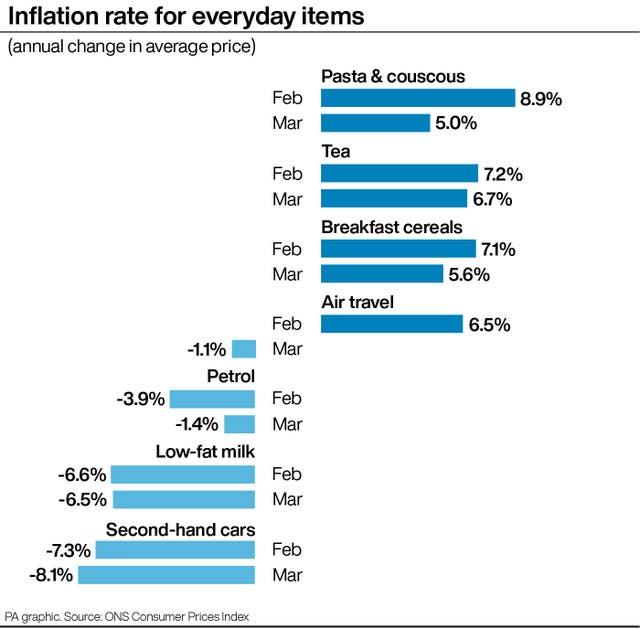
UK inflation slowed slightly less than expected last month, leading to City economists and investors trimming their forecasts for interest rate cuts this year.
Official figures showed that inflation dipped in March to its lowest level since September 2021, driven by slower increases for food prices.
The Office for National Statistics (ONS) said Consumer Prices Index inflation stood at 3.2% in March, down from 3.4% in February.
It showed a slowdown in the rising cost of living, but was still above the 3.1% reading expected by a consensus of experts.

The data, which also showed higher than expected services inflation, came after the ONS revealed on Tuesday that wage growth is also stronger-than-expected, after a 6% rise in the three months to February.
As a result, many City economists pushed back their forecasts for reductions to interest rates.
UK interest rates currently sit at a 15-year high of 5.25% after hikes by the Bank of England in an effort to quash inflation.
Experts at ING and Pantheon Macroeconomics were among those who earlier this week predicted rate-setters at the Bank would start cuts in June, but said they now expect this to happen later in the summer, most likely at the Monetary Policy Committee’s August meeting.
ING’s James Smith said the data “all but rules out a rate cut in May, and if we’re right that April’s data proves stickier than the Bank is expecting, then we think that would drastically reduce the chances of a cut in June, too”.
Meanwhile, the often volatile financial markets were even more pessimistic, pricing in that rate cuts will only begin in November.
Prime Minister Rishi Sunak said the figures show “that after a tough couple of years, our economic plan is working”, although the reduction in inflation is primarily linked to interest rate rises by the Bank of England and changes to global price pressures.
The drop was heavily linked to a slowdown in food price inflation, which was also its lowest for more than two years.
ONS chief economist Grant Fitzner said: “Inflation eased slightly in March to its lowest annual rate for two-and-a-half years.
“Once again, food prices were the main reason for the fall, with prices rising by less than we saw a year ago.
“Similarly to last month, we saw a partial offset from rising fuel prices.”
Inflation for food and non-alcoholic drinks dipped to 4% for the month, from 5% in February, to reach its lowest level since November 2021.
The increased slowdown was partly driven by a fall in meat prices and lower rises for bread and cereals, the ONS said.
Furniture and household goods prices also contributed to the fall, with prices in the sector down 0.9% in March compared with the same month last year.
Elsewhere in retail, clothing and footwear inflation also slowed to 4% for the month, from 5% in February, after women’s clothing stores increased prices by less than normal for this time of year.

The largest upwards pressure came from motor fuels, after the average price of petrol rose by 2.6p per litre between February and March 2024 to stand at 144.8 pence per litre, according to the ONS.
The overall reduction in inflation comes after rate setters at the Bank of England hiked interest rates to a 15-year high of 5.25% in order to put pressure on demand.
Economists expect inflation for April to show a further fall, supported by another drop in energy prices, as CPI moves closer towards the central Bank’s 2% target rate.
This has also increased speculation that the central bank could cut interest rates in the coming months, although Governor Andrew Bailey and other members of the Bank’s monetary policy committee have so far suggested it is too early for a cut.
Ian Stewart, chief economist at Deloitte, said: “Inflation is in retreat but the Bank of England cannot yet be sure that it is beaten.
“Headline inflation is likely to drop below 2% in the coming months, but to be confident it will stay there wage pressures need to ease.
“With earnings growing at close to 6%, and the economy reviving, the Bank will be in no hurry to cut interest rates.”

On Tuesday, official figures showed regular wages growth, excluding bonuses, at 6% in the three months to February, which was a slight fall but also above economist predictions.
On Wednesday, Mr Sunak told broadcasters: “Today’s figures show that after a tough couple of years, our economic plan is working and inflation continues to fall.
“We have also seen energy bills falling, mortgage rates falling and, just this week, data showed people’s wages have been rising faster than inflation for 12 months in a row.
“My simple message would be: if we stick to the plan, we can ensure that everyone has a brighter future.”
Chancellor Jeremy Hunt said: “The plan is working: inflation is falling faster than expected, down from over 11% to 3.2%, the lowest level in nearly two-and-a-half years, helping people’s money go further.”
Rachel Reeves, Labour’s shadow chancellor, said: “Conservative ministers will be hitting the airwaves today to tell the British people that they have never had it so good.
“Prices are still high in the shops, monthly mortgage bills are going up and inflation is still higher than the Bank of England’s target.”

Enjoy the convenience of having The Sunday Post delivered as a digital ePaper straight to your smartphone, tablet or computer.
Subscribe for only £5.49 a month and enjoy all the benefits of the printed paper as a digital replica.
Subscribe